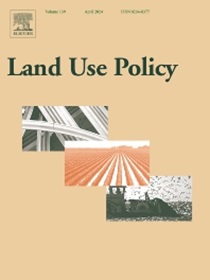保护绿色基建遗产的可持续管理策略。意大利安科纳市传统的橄榄树景观
IF 6
1区 社会学
Q1 ENVIRONMENTAL STUDIES
引用次数: 0
摘要
在过去的一个世纪里,城市化逐渐导致开放空间的破碎和退化,包括橄榄园等传统景观。城市和城郊橄榄遗产的保护对生物多样性保护、气候调节和文化认同至关重要。然而,尽管古橄榄园具有生态和历史意义,但由于城市扩张、自然和农业资源的逐渐流失、财政约束以及缺乏有针对性的规划政策,古橄榄园越来越被忽视。为了抵消这一趋势,需要将规划程序与参与性管理方法和公民积极参与相结合的综合战略。本研究通过安科纳的案例研究,探讨了橄榄树保护的整体方法,在现有的城市规划系统中测试了参与式管理框架。通过整合土地评估、规划工具分析和社会经济战略,该研究提出了一个可扩展的三步方法,旨在保护景观遗产,同时促进社会包容和经济可持续性。研究结果强调,积极的公民参与和多方利益相关者合作是确保保护项目长期可行性的关键因素。此外,该研究还强调了政策创新和财政机制实施的必要性,如农业环境协议和遗产保护激励措施,以提高这些倡议的经济可持续性。最终,本研究有助于将绿色基础设施和文化景观保护纳入城市和区域规划的更广泛讨论,为在城市化背景下加强橄榄遗产的复原力提供了一个可复制的模型。本文章由计算机程序翻译,如有差异,请以英文原文为准。
Sustainable management strategy to preserve Green Infrastructure Heritage. The traditional landscape of olive trees in the city of Ancona, Italy
Over the past century, urbanization has progressively led to the fragmentation and degradation of open spaces, including traditional landscapes such as olive orchards. The preservation of olive heritage in urban and peri-urban contexts is essential for biodiversity conservation, climate regulation, and cultural identity. However, despite their ecological and historical significance, ancient olive groves are increasingly neglected due to urban expansion, the gradual loss of natural and agricultural resources, financial constraints, and the absence of targeted planning policies. To counteract this trend, integrated strategies that combine planning procedures with participatory management approaches and active citizen engagement are necessary. This study investigates a holistic approach to olive tree preservation through the case study of Ancona, where a participatory management framework was tested within the existing urban planning system. By integrating territorial assessment, planning tool analysis, and socio-economic strategies, the study proposes a scalable three-step methodology aimed at safeguarding landscape heritage while fostering social inclusion and economic sustainability. The results underscore that active citizen involvement and multi-stakeholder collaboration are critical factors for ensuring the long-term viability of preservation programs. Furthermore, the study highlights the necessity of policy innovation and the implementation of financial mechanisms, such as agri-environmental agreements and heritage conservation incentives, to enhance the economic sustainability of these initiatives. Ultimately, this research contributes to the broader discourse on integrating green infrastructure and cultural landscape preservation into urban and regional planning, offering a replicable model for strengthening the resilience of olive heritage in urbanized contexts.
求助全文
通过发布文献求助,成功后即可免费获取论文全文。
去求助
来源期刊

Land Use Policy
ENVIRONMENTAL STUDIES-
CiteScore
13.70
自引率
8.50%
发文量
553
期刊介绍:
Land Use Policy is an international and interdisciplinary journal concerned with the social, economic, political, legal, physical and planning aspects of urban and rural land use.
Land Use Policy examines issues in geography, agriculture, forestry, irrigation, environmental conservation, housing, urban development and transport in both developed and developing countries through major refereed articles and shorter viewpoint pieces.
 求助内容:
求助内容: 应助结果提醒方式:
应助结果提醒方式:


